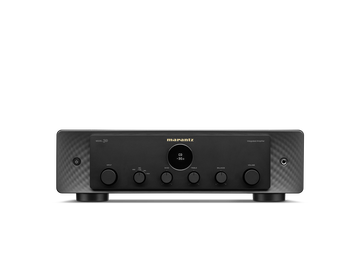Built on Heroes of the Past
In 1960, Paul Simon, Neil Diamond and Lou Reed were New York's most exciting young artists. The computer mouse, etch a sketch, countertop microwave oven and the audio cassette had just been invented. Thanks to the efforts of guitar hero Les Paul, multitrack recording had become standard for both consumption and recording. His company, Ampex, had created the eight-track studio recorder, enabling people to record instruments separately and mix them into one cohesive composition, and so music lovers were looking for technologies that could accurately reproduce those recordings.
Since 1953, Saul Marantz had been developing a series of amplifiers from his home in Kew Gardens, Queens. Having found success with his audio consolette, Saul evolved the product into the MODEL 1, which, with a great deal of tinkering became the MODEL 2, and so on, until in 1960 he released the MODEL 9, a groundbreaking new amplifier.

Using EL34 tubes, this ultra-linear parallel push-pull design produced 70 watts of power, a significant accomplishment for its time. The increased power resulted, in part, from the strong rivalry with McIntosh, whose power amplifiers (at the time) were generally more muscular than comparable Marantz models. It’s worth noting that the MODEL 9 can also be set in triode operation for even better sound at lower wattage.
In addition to its high power, the MODEL 9 reached new cosmetic horizons thanks to a bias meter centered on the front panel and a drop-down front panel door that concealed adjustments and connections. Until then, Marantz products had been more industrial-looking devices designed to be hidden away, but Saul was coming to realise that the audiophile was as equally as concerned about interior design, and that highend audio equipment was something that should be put on display.
Mid-century design and architecture is one of the most significant design movements to date. It was during this period that folks began to care more about how their homes looked, and indeed about how their music sounded. Bauhaus had infiltrated New York, while designers like Eames, Bertoia, Saarinen, Wright, and Le Corbusier were creating aspirational products and places. The MODEL 9 was designed to align with, and perhaps accentuate, such sought-after statement pieces, and the certain lifestyle they represented.




Yet the MODEL 9 was more than just a looker. It was one of the first amplifiers to use a meter and knob to perform different test functions (at gain zero). It is equipped with trimmers to adjust the bias of every output tube, but also to set AC and DC balance, which was of course incredibly convenient for the user at that time as it meant that no scope or other testing equipment was needed. And such was the amplifier’s smooth control and stability of power, NASA famously customized the MODEL 9 for use in the Apollo Space Program.
Meanwhile, the “porthole” power meter – in addition to allowing users to easily compensate for different tube characteristics – extended the Marantz tradition of integrating functionality with form, providing a trademark that is still used by Marantz today. Again, it is Saul’s understanding of mid-century design that has meant the porthole has stood the test of time. It is iconic today, as it was 60 years ago.
Like many products at the time, self assembly was required, partly in the interest of keeping the price down. Each unit came with a manual, test card and schematic diagram, as well as an accessory kit containing an assortment of screws and an Allen key. The instruction manual goes on to say, “The MODEL 9 is remarkably cool in its normal operation.” Admittedly it does then warn that any amplifier will become hot if not allowed to freely dissipate itself into the surrounding air...
But still, it is remarkably cool.







